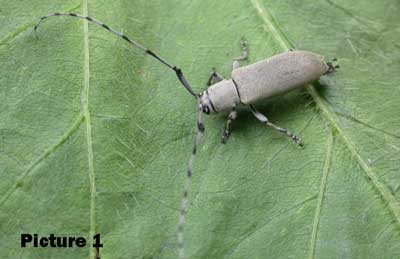
- Larvae of Dectes stem borer overwinter in the base of hollow girdled stems.
- Although they only have one generation per year, the adults of Dectes stem borer have a long emergence period.
- Although economic damage from this pest is rarely reported in the Midwest, girdling by the larva can result in soybean lodging.
- Management options include a combination of cultural practices such as weed control programs to eliminate alternate hosts, tillage to reduce infested crop residue and early harvest to prevent lodging.
Identification and Life Cycle
Dectes stem borer (DSB) is a longhorn beetle that belongs to the family Cerambycidae. The adults are gray in color and about 3/8" long with long antennae (Pic. 1). The larvae are white in color with an orange-red head, about 1/2" long and accordion-like in appearance (Pic. 2). Larvae of DSBare mainly a pest of woody plants but they can also feed on herbaceous weeds like cocklebur, giant ragweed and crops like sunflowers and soybeans. They overwinter as larvae in the base of hollow, girdled stems. The larvae feed and pupate in the stems of host plants in late spring-early summer and adults have an extended emergence period beginning in late June through September. Shortly after emergence the adults deposit eggs in soybean petioles. There is one single generation per year.
Damage to Soybeans
Soon after hatching, the larvae feed on the outer stem of soybean plants before they bore into the main stem while feeding on pith tissue. This type of damage can interfere with translocation of water and nutrients to developing pods and seeds. In late summer, as soybeans mature, DSB larvae would have tunneled down to the base of the plant and eventually girdle the stem. This type of damage may result in lodging especially when windy or rainy weather is observed. However, in the Midwest, rarely DSB causes economic damage in soybean. When reported, infested fields may be associated with no-till soybean plantings in which plant crowns are left undisturbed providing suitable overwintering sites for the larvae of DSB.
Scouting
Because they live inside the stem, scouting for DSB larvae can be difficult. Lodging may be the only indication of DSB larval presence in a field. If lodged plants are found, cut open the stems lengthwise and look for the presence of the larva and its feeding damage. Unfortunately, lodging may not always occur in infested plants and by the time it is observed, the damage has already been done. Nonetheless, even after lodging has occurred, these counts will give you an idea of DSB infestations the following year. Adults can be sampled from June through August using sweep nets. "Suggested" treatment threshold are 1 DSB adult/ 10 sweeps.
Management
Insecticides: Controlling DSB with insecticides is difficult because the larvae are protected inside the stem. Adults have a better chance at being affected by insecticide applications but because of their extended emergence period, multiple applications would be required to effectively control them.
Weed control: Since important herbaceous weeds are also hosts of DSB, an effective weed control program is recommended to reduce DSB infestations in soybean fields.
Tillage practices: Avoid planting soybeans on no-till or reduced-till fields when possible as they will promote the survival of the overwintering larvae of DSB. Disking or burying infested soybean stems after harvest may reduce the number of overwintering populations.
Harvest: Growers who scout their fields and find DSB infested plants should harvest their crop as soon as possible to minimize lodging.
Contact your FS Crop Specialist for your agronomic information.

Picture 1: Adult of Dectes stem borer. (Source: GROWMARK, Inc.)
Picture 2: Larva of Dectes stem borer in soybean stem (Source: GROWMARK, Inc.)